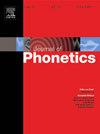预期鼻音共同发音的语言特点和个体差异:美国英语、法语和德语比较研究
IF 2.4
1区 文学
0 LANGUAGE & LINGUISTICS
引用次数: 0
摘要
预期性语境鼻化,即鼻辅音前的口语片段(通常是元音)部分或全部鼻化,在试图揭示共时性领域预测因素的研究中受到了广泛关注。在这项研究中,有人认为元音鼻音在语言中的语音地位可以决定语音鼻音共时的时间范围。我们对美式英语、北方都会法语和标准德语中的预期鼻音共同发音进行了比较研究。这些语言的不同之处在于鼻音是对比性的(法语)、表面上是语音化的但不是对比性的(美式英语),还是两者都不是(德语)。我们在鼻音或口腔控制辅音之前的一个相对较大的时间间隔内测量鼻音强度。在英语中,共同发音具有最大的时域,而在法语中,预期鼻音化则更受限制。德语与英语不同,但与法语不同。虽然这些结果证实了一些预期的语言特异性效应,但它们也强调,如果上下文不抑制 velum 降低,预期鼻音共时化的时间范围可以超过前面的元音。对于所有语言而言,在元音序列中,共同发音的开始时间可能大大早于前鼻韵母,英语尤其如此。我们认为,在英语中,前鼻韵母本身已成为共发音的来源,因此美式英语的前鼻韵母鼻音对共发音鼻化没有启示作用。语言之间的个体差异程度与鼻化在语音学或语音学上的作用相一致。总之,我们的数据进一步加深了我们对预测性共发音的非局部时间范围及其特定语言表达的理解。本文章由计算机程序翻译,如有差异,请以英文原文为准。
Language-specific and individual variation in anticipatory nasal coarticulation: A comparative study of American English, French, and German
Anticipatory contextual nasalization, whereby an oral segment (usually a vowel) preceding a nasal consonant becomes partially or fully nasalized, has received considerable attention in research that seeks to uncover predictive factors for the temporal domain of coarticulation. Within this research, it has been claimed that the phonological status of vowel nasality in a language can determine the temporal extent of phonetic nasal coarticulation. We present a comparative study of anticipatory nasal coarticulation in American English, Northern Metropolitan French, and Standard German. These languages differ in whether nasality is contrastive (French), ostensibly phonologized but not contrastive (American English), or neither (German). We measure nasal intensity during a comparatively large temporal interval preceding a nasal or oral control consonant. In English, coarticulation has the largest temporal domain, whereas in French, anticipatory nasalization is more constrained. German differs from English, but not from French. While these results confirm some of the expected language-specific effects, they underscore that the temporal extent of anticipatory nasal coarticulation can go beyond the preceding vowel if the context does not inhibit velum lowering. For all languages, the onset of coarticulation may considerably precede the pre-nasal vowel in VN sequences, especially so for English. We propose that in English, the pre-nasal vowel has itself become a source of coarticulation, making American English pre-nasal vowel nasality uninformative about coarticulatory nasalization. Degrees of individual variation between the languages align with the phonological or phonologized role of nasalization therein. Overall, our data further add to our understanding of the non-local temporal scope of anticipatory coarticulation and its language-specific expressions.
求助全文
通过发布文献求助,成功后即可免费获取论文全文。
去求助
来源期刊

Journal of Phonetics
Multiple-
CiteScore
3.50
自引率
26.30%
发文量
49
期刊介绍:
The Journal of Phonetics publishes papers of an experimental or theoretical nature that deal with phonetic aspects of language and linguistic communication processes. Papers dealing with technological and/or pathological topics, or papers of an interdisciplinary nature are also suitable, provided that linguistic-phonetic principles underlie the work reported. Regular articles, review articles, and letters to the editor are published. Themed issues are also published, devoted entirely to a specific subject of interest within the field of phonetics.
 求助内容:
求助内容: 应助结果提醒方式:
应助结果提醒方式:


